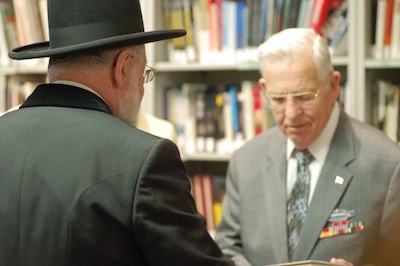By Emily K. Alhadeff, Associate Editor, JTNews
Leo Hymas was 18 years old when he and three other American soldiers, members of General Patton’s Third Army, used Bangalore torpedoes to blow open the gate at Buchenwald.
He was not prepared for what he would find.
“I had no idea; never heard of such a thing,” he said of the 18,000 emaciated prisoners he found living in squalor. “I wanted to kill every German I could find.”
Now 86 years old, the Whidbey Island resident is on the Washington State Holocaust Education Resource Center’s Speakers Bureau. Already this year, Hymas said, he’s shared his story 22 times.
On June 22, a rainy Friday, Hymas and his wife waited at the Holocaust Center in downtown Seattle to meet Rabbi Lau. The former chief rabbi of Israel came to the center to mingle informally with Hymas; Klaus and Paula Stern, two of the first Auschwitz survivors to come to Seattle; Henry Friedman, who spent the war as a child in hiding; and Magda Schaloum, who was imprisoned at Auschwitz and whose father was killed at Buchenwald.
When his turn came to speak with the rabbi, Hymas had one question: “Can you forgive us for not coming sooner?”
“It’s not your fault,” Rabbi Lau responded.
Hymas says that telling his story with the Holocaust Center for the past 16 years has been a healing process. “Each [talk] helps me overcome the terrible, terrible memories that I have,” he says.
The remaining SS guards at Buchenwald were ordered to kill the prisoners, destroy the records and burn the camp down. A large company of Americans came to the aid of Hymas and his comrades, because, he said, “we had to knock off a few guards.” Generals Patton and Eisenhower arrived with their staffs, and Eisenhower ordered the media to take pictures.
“Someday there will be people who will say this didn’t happen,” Hymas remembers him saying.
The American troops gathered civilians living in nearby Weimar and brought them to the camp.
“They claimed they didn’t know anything about it,” he said. The soldiers made them each carry a body over their shoulder to a mass grave.
After liberating Buchenwald, Hymas helped liberate Prague, where he caught a roomful of Nazi soldiers and Gestapo changing out of their uniforms into civilian clothes.
“We caught them right in the very act,” said Hymas. In the process, he found an American pistol tucked inside a German’s coat pocket.
“I pushed my pistol up his nose, and I came this close to pulling the trigger,” he said.
But Hymas, who is Mormon, remembered God, and instead stripped the soldier of his medals and took him to a prisoner-of-war camp.
Hymas was shipped out to Japan after his European tour, but the atomic bombs blew up over Nagasaki and Hiroshima while he was on the way. Back in America, the Utah native married his high school sweetheart, Amy, and did some police work for the military before being honorably discharged at the age of 20. Later he moved to the Seattle area to work for Boeing.
“I’m grateful I survived,” he said. “I’m pleased I had the opportunity to save so many people. I look back on it as a learning experience, for me to learn to love my God and his children, who are my brothers and sisters.”
Hymas is proud to have brought freedom to the survivors of Buchenwald, and Rabbi Lau, who was barely 8 years old at the time.
The German plan to extinguish the Jewish people is “the most evil, the most wicked thing I’ve ever heard about,” said Hymas. “I’m so grateful I had one little part in bringing it to an end.”
